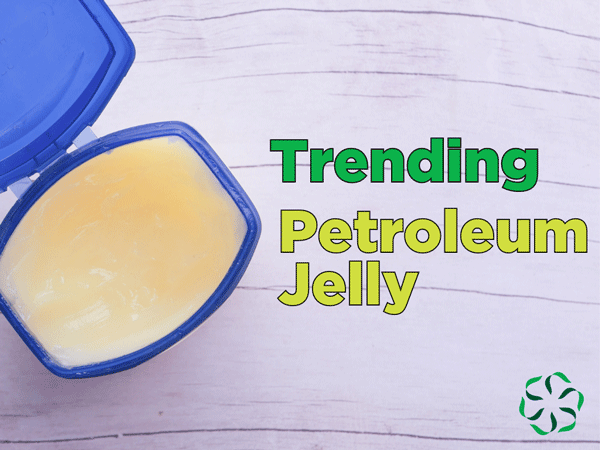We’ve seen misinformation and confusion around petroleum jelly make its way around the Internet. In this post, we look at petroleum jelly.
What is petroleum jelly?
There are many names for petroleum jelly. The most common is petrolatum and white petrolatum. It’s made of hydrocarbons, and manufacturers refine the material into an odorless, semi-solid product.
Humans have used petroleum jelly-like products for hundreds of years. Still, the most familiar petroleum jelly product became popular in the late 1800s when the North American oil industry began, and chemist Robert Chesebrough developed an effective distillation and refining process.
Petroleum jelly is generally categorized into three different types:
- Industrial
- Medical
- Cosmetic
This post will focus on medical and cosmetic uses for petroleum jelly.
How does it work? What do we use it for?
In general, petroleum jelly’s waxy, gel-like consistency creates a barrier between the skin and the outside environment.
For health and healing, petroleum jelly can
- Aid in wound and burn healing
- Prevent and help heal chapped skin and lips
- Prevent skin rashes and chafing
- Help prevent scarring when used on minor wounds
- Be used as a base for many antibacterial and antimicrobial ointments
The barrier keeps potentially harmful microorganisms out of minor wounds, which can help prevent infection, thus encouraging healing (1,2). Additionally, petroleum jelly’s barrier properties help prevent transdermal moisture loss, meaning skin stays hydrated.
For cosmetic uses, petroleum jelly can
- Serve as an occlusive (e.g., barrier)
- Serve as an emollient (e.g., soften skin)
- Add shine and protective properties to haircare products
We frequently find petroleum jelly in cosmetic products to help retain skin moisture, create smooth, spreadable products, and act as effective occlusive and emollient ingredients.
Does it cause adverse health outcomes?
Very rarely, some individuals may have petroleum jelly allergies and should avoid using petroleum jelly and products that contain petroleum jelly.
Some medical professionals prefer petroleum jelly over other ointment products with additional ingredients that may not aid healing or are more commonly allergenic for individuals.
As always, you should talk with your medical professional if you have concerns.
Is petroleum jelly carcinogenic?
While some data suggests that compounds found in petroleum jelly could be carcinogenic in typical use, specifically Mineral Oil Aromatic Hydrocarbons (MOHA) and polyaromatics. There is limited evidence to support this claim, and the ingredient remains safe in cosmetics, topical ointments, and even foods when processed properly (1,2,3).
Are fossil fuels involved in the production of petroleum jelly?
Yes, it’s a hydrocarbon-based product. Hydrocarbons are the primary component of petroleum and natural gas. Manufacturers make petroleum jelly from the leftover petroleum material from oil and gas production.
Manufacturers refine the hydrocarbon compounds to create petroleum jelly to filter out any undesirable impurities.
The good news.
We don’t need expensive products to help protect our skin and heal minor cuts and burns. Petroleum jelly is safe, effective, and affordable without extra, potentially irritating ingredients.
If you have any questions about foods and ingredients, please reach out to us on Twitter, send us an email, or submit your idea to us at go.msu.edu/cris-idea.

